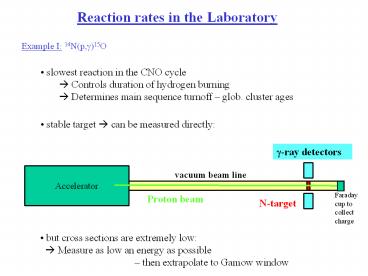Reaction rates in the Laboratory - PowerPoint PPT Presentation
Title:
Reaction rates in the Laboratory
Description:
Reaction rates in the Laboratory Example I: 14N(p,g)15O slowest reaction in the CNO cycle Controls duration of hydrogen burning Determines main sequence turnoff ... – PowerPoint PPT presentation
Number of Views:129
Avg rating:3.0/5.0
Title: Reaction rates in the Laboratory
1
Reaction rates in the Laboratory
Example I 14N(p,g)15O
- slowest reaction in the CNO cycle
- Controls duration of hydrogen burning
- Determines main sequence turnoff glob. cluster
ages
- stable target ? can be measured directly
g-ray detectors
Accelerator
vacuum beam line
Faraday cup to collect charge
Proton beam
N-target
- but cross sections are extremely low
- ? Measure as low an energy as possible
then extrapolate
to Gamow window
2
Calculating experimental event rates and yields
beam of particles
hits target at rest
area A
j,v
thickness d
assume thin target (unattenuated beam intensity
throughout target)
Reaction rate (per target nucleus)
Total reaction rate (reactions per second)
with nT number density of target nuclei
I jA beam number current (number of
particles per second hitting the target)
note dnT is number of target nuclei per cm2.
Often the target thickness is specified
in these terms.
3
Events detected in experiment per second Rdet
e is the detection efficiency and can accounts
for
- detector efficiency (fraction of
particles hitting a detector that produce
a signal that is registered) - solid angle limitations
- absorption losses in materials
- energy losses that cause particles energies to
slide below a detection threshold
4
14N(p,g) level scheme
Gamow window0.1 GK 91-97 keV
g-signature of resonance6791 keV
g0
Direct gs capture7297 keV Ep
5
LUNALaboratory Underground for Nuclear
Astrophysics(Transparencies F. Strieder
http//www.jinaweb.org/events/tucson/Talk_Strieder
.pdf)
Gran Sasso Mountain scheme
11 Mio cosmic ray suppression
6
Spectra above and under ground
7
Beschleuniger bild
8
Setup picture
9
Spectrum overall
10
Spectrum blowup
11
Results
GamowWindow
Formicola et al. PLB 591 (2004) 61
New S(0)1.7 - 0.2 keVb (NACRE 3.2 - 0.8)
12
New Resonance ?
Resonance claim and TUNL disproof
13
Effect that speculative resonance would have had
14
Example II 21Na(p,g)22Mg
problem 21Na is unstable (half-life 22.5 s)
solution radioactive beam experiment in inverse
kinematics 21Na p ? 22Mg g
thick 21Na production target
hydrogen target
22Mg products
Accelerator I
Accelerator 2
p beam
21Na beam
g-detectors
ionsource
particleidentification
difficulty beam intensity typically 107-11 1/s
(compare with 100 mA protons 6x1014/s)
? so far only succeeded in 2 cases 13N(p,g) at
Louvain la Neuve and 21Na(p,g) in
TRIUMF (for capture reaction)
15
(No Transcript)
16
(No Transcript)
17
DRAGON _at_ TRIUMF
18
Results
Result for 206 keV resonance
S. Bishop et al. Phys. Rev. Lett. 90 (2003) 2501
19
Example III 32Cl(p,g)33Ar
Shell model calculations Herndl et al. Phys. Rev.
C 52(1995)1078
? proton width strongly energy dependent? rate
strongly resonance energy dependent
20
NSCL Coupled Cyclotron Facility
21
Installation of D4 steel, Jul/2000
22
Fast radioactive beams at the NSCL
- low beam intensities
- Impure, mixed beams
- high energies (80-100 MeV per nucleon)
(astrophysical rates at 1-2 MeV per nucleon)
? great for indirect techniques
- Coulomb breakup
- Transfer reactions
- Decay studies
23
Setup
Focal planeidentify 33Ar
S800 Spectrometer at NSCL
34Ar
Beamblocker
33Ar
33Arexcited
34Ar
d
Plastic
People
Plastictarget
34Ar
D. Bazin R. Clement A. Cole A. Gade T.
Glasmacher B. Lynch W. Mueller H. Schatz B.
Sherrill M. VanGoethem M. Wallace
Radioactive 34Ar beam84 MeV/u T1/2844 ms(from
150 MeV/u 36Ar)
SEGAGe array(18 Detectors)
24
S800 Spectrometer
SEGA Ge-array
25
New 32Cl(p,g)33Ar rate Clement et al. PRL 92
(2004) 2502
Doppler corrected g-rays in coincidence with
33Ar in S800 focal plane
g-rays from predicted 3.97 MeV state
stellar reaction rate
reaction rate (cm3/s/mole)
33Ar level energies measured 3819(4) keV (150
keV below SM) 3456(6) keV (104 keV below SM)
temperature (GK)
Typical X-ray burst temperatures
26
Fast beams
Gas cell
27
(No Transcript)
28
and p-process
Rates in pps
gt108
direct (p,g)
107-8
106-7
direct (p,a) or (a,p)transfer
105-6
104-5
(p,p), some transfer
102-4
Up to here For indirect measurements many For
direct measurements some important rates
- Capabilities
- sufficient beam intensities for many important
measurements - all beams available once system commissioned
- probably very good beam purity
- none of the measurements identified can be
performed at another facility as of now
29
Overview of the FRIB Layout
30
ReA12 and Experimental Areas
- A full suite of experimental equipment will be
available for fast, stopped and reaccelerated
beams - New equipment
- Stopped beam area (LASERS)
- ISLA Recoil Separator
- Solenoid spectrometer
- Active Target TPC
31
Direct measurementsfor many (a,g) reactions in
p-process
Rates in pps
10gt10
109-10
108-9
107-8
All reaction rates can beindirectly
measuredincluding 72Kr waiting point
106-7
105-6
104-5
102-4
most reaction rates up to Sr can bedirectly
measured
All reaction rates up to Ti can be directly
measured
? Very strong nuclear astrophysics science case































